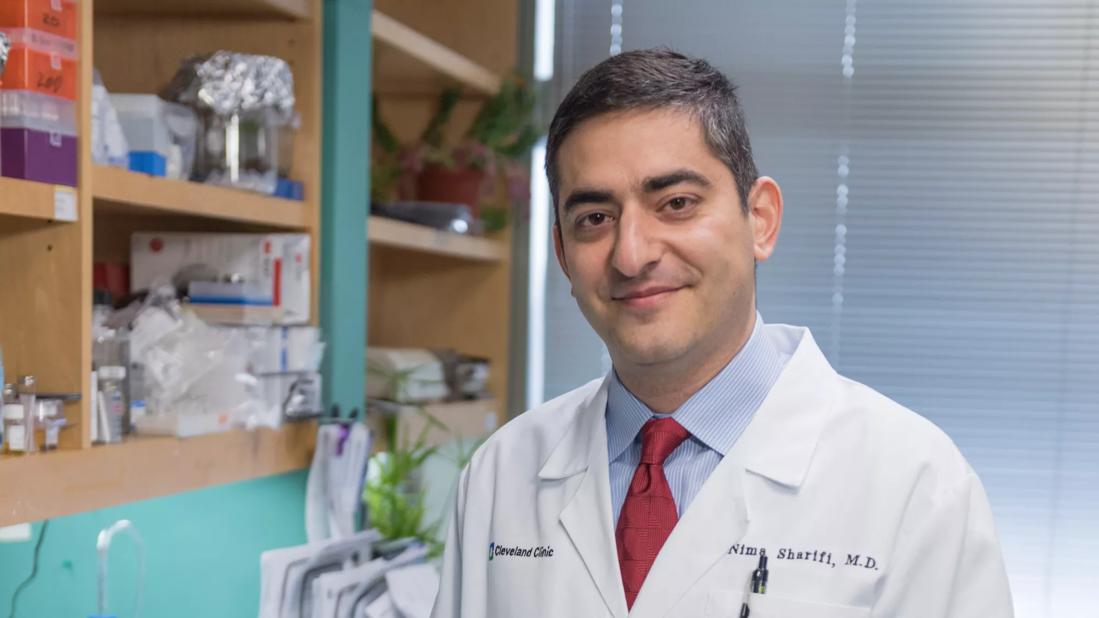New findings in prostate and kidney cancer

In the two years since the Genitourinary (GU) Malignancies Research Center was created, Director Nima Sharifi, MD, has seen a flurry of bench studies become clinical studies, as well as clinical questions spark new bench research. A joint initiative of Cleveland Clinic’s Glickman Urological & Kidney Institute and Lerner Research Institute, the center is a hub for urologists, oncologists, pathologists and basic scientists working to transform the care of patients with kidney, bladder or prostate cancer.
Advertisement
Cleveland Clinic is a non-profit academic medical center. Advertising on our site helps support our mission. We do not endorse non-Cleveland Clinic products or services. Policy
“We’re transcending disciplines, so lab researchers and clinicians increase and optimize their interactions, reaching into the clinic in a way that is really meaningful,” says Dr. Sharifi.
Take for example the center’s recent study of prostate cancer patients taking androgen-receptor (AR) antagonists. Published in Annals of Oncology, the study found that levels of biologically active glucocorticoids in these patients — while known to be elevated in tumor tissue — were elevated systemically as well.
Patients took either apalutamide or enzalutamide, both AR antagonists, in one of three clinical trials. After one month, patients in all three trials showed a statistically significant increase in cortisol and its metabolites, according to liquid chromatography–mass spectrometry.
“This study, while heavy in biochemistry, is really a patient-centric story,” says Dr. Sharifi. “Although we identified the metabolic change in the lab, it’s not something that just happens in mouse models. The clinical findings were quite clear: AR antagonists can alter a patient’s metabolism.”
That may be most concerning for men with earlier stage prostate cancer who take AR antagonists long-term. Elevated glucocorticoid levels aren’t without consequence. One subset of patients in the study developed hypertension (although the mechanism linking it to the AR antagonist is uncertain). Immunosuppression and central nervous system effects, such as asthenia and changes in mental status, may be other repercussions.
Advertisement
“This study could have broad implications,” says Dr. Sharifi. “More research is needed to determine how best to treat hypertension and other adverse effects in patients taking AR antagonists. There’s more to study about combination therapy, particularly related to immunotherapy. And changing cortisol levels could become a biomarker for prostate cancer.”
Others in the center are making remarkable progress in understanding kidney cancer. Abhishek A. Chakraborty, PhD, Assistant Staff in the Department of Cancer Biology at Lerner Research Institute, is studying a specific protein that regulates amino acid metabolism in both normal and malignant kidney cells. The work is supported by a $1 million Early-Career Investigator Award that Dr. Chakraborty received in 2020 from the U.S. Department of Defense’s Kidney Cancer Research Program.
“In kidney cancer cells, the protein is upregulated, picking up more than its normal share of amino acids,” says Dr. Chakraborty. “It’s like cancer cells are addicted to these nutrients, which keep the cells growing and spreading.”
Dr. Chakraborty’s lab will study how blocking the protein affects kidney cancer development and progression. They also will explore the effects of nearly 100 potential oncogenes — like the one that hijacks the amino acid absorption process — a continuation of the work Dr. Chakraborty began as a postdoctoral fellow at Dana–Farber Cancer Institute.
“Two decades ago, kidney cancer was primarily managed surgically,” he says. “Today we have more therapy options, like checkpoint inhibitors and tyrosine kinase inhibitors. Even so, the best response rate for advanced kidney cancer is only 65%. We need to keep improving outcomes by improving therapies by identifying more therapeutic targets. The protein that my lab is exploring may one day be another.”
Advertisement
Understanding the fundamental biology of cancer is the first step in finding new and better therapies, says Dr. Chakraborty. But making the leap from discovery to changing practice takes a sustained effort, sometimes over 5-10 years, adds Dr. Sharifi.
“Good working relationships across disciplines, where people understand each other’s language, are helpful,” he says. “Could it happen if we didn’t have a GU Malignancies Research Center? Maybe. But having the center formalizes those interactions and ensures that we do much more with what we already have at hand.”
Advertisement
Advertisement

Study shows high rate of hematologic responses, low rate of disease progression

Bispecific antibody bridging therapy deepens durability of BCMA CAR T-cell therapy without overlapping toxicities in patients with relapsed/refractory multiple myeloma

Phase 2 study brings pivotal advances in treatment efficacy and safety for the most challenging-to-treat population

Patient with quadruple refractory multiple myeloma achieves complete response with cell therapy

Distinct baseline immune profiles can predict response and resistance to different types of CAR-T cells.

National Blood Clot Alliance collaborates with faith-based organizations on first-of-its-kind church bus tour

AI-driven tools can streamline enrollment and improve efficiency across clinical trials.

Patient achieves complete remission from aggressive marginal zone lymphoma with liso-cel